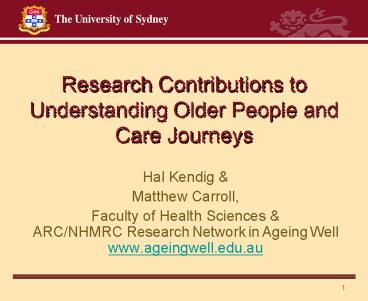Research Contributions to Understanding Older People and Care Journeys PowerPoint PPT Presentation
1 / 20
Title: Research Contributions to Understanding Older People and Care Journeys
1
Research Contributions to Understanding Older
People and Care Journeys
- Hal Kendig
- Matthew Carroll,
- Faculty of Health Sciences
ARC/NHMRC Research Network in Ageing Well
www.ageingwell.edu.au
2
Acknowledgements
- MELSHA key collaborators
- Prof Colette Browning Co-Director with Hal
Kendig - Prof Shane Thomas collaborator in data
collection strategies and health services
analyses - A/Prof Dave Grayson statistical consultant
- Note Results will be forthcoming in articles
written with the collaborators
3
Overview
- Policy ideas and information sources
- Findings
- Research directions
- Funding opportunities
- Policy directions
4
1.a The Pathways Approach
- What it is
- Key questions
- How do peoples community care services change
over 11 years - What predicts entry to residential care?
5
1.b Why take the Pathways Approach?
- Better understand
- Multiple use of services
- Duration of services use
- Predictors of key turns on paths
- and how it helps improve understanding of the
aged care systems
6
1.c Current efforts in services pathways
- Gibson and Duckett
- Pathways in Aged Care (dementia study)
- NSW Health Department
- Care Journeys
7
1.d. The MELSHA Program(Browning and Kendig)
- Data Base 1994 Baseline Interviews with 1000
persons aged 65 years and over living in the
community. - Biannual telephone and tracing efforts to 2002
and 2006 with face to face in 2004. - Funding - National Health and Medical Research
Council Funding and Victorian Health Promotion
Foundation
8
2. Findings
9
2.a Baseline Characteristics
- Capacities - Full instrumental independence
(81) - at baseline - Good or better self rated health
(81) - - Can walk two plus kilometres (70)
- Well-being - Frequently happy etc (80 plus)
- - High life satisfaction (80 plus)
- Risks - Most no energetic exercise - Less than
half daily fruit, vegies, milk - - A third of women fell in last year
- - 15 five plus prescribed medications
- - A third have some incontinence
10
2.b Baseline characteristics cont.
MELSHA Baseline 1994 n 1000
Yes 175
No 825
IADL Dependent
With spouse 75
Living arrangement
Alone 75
With spouse 496
With others 69
Alone 260
With others 25
F 42
M 335
F 46
M 23
F 19
M 6
M 10
F 65
F 161
F 200
M 60
M 33
Gender
11
2.c Outcomes after 11 years of the study
preliminary analyses
- 42 in the community
- 7 in residential care
- 50 known to have died
- (of whom 33 known to have entered residential
care) - Excludes the 18 of the sample that was lost
to follow up and hence outcomes were not known
12
2.d Service Use () at baseline groups
13
2.e HACC Service use () by year of data
collection
14
2.f Outcomes by year of data collection
15
2.g Identified service use () prior to
residential care admission or death
16
2.h Question 2 most important predictors of
entry to residential care
- From a total of 30 variables covering
socioeconomic, health and lifestyle domains
17
3a Future research directions
- Further analysis of MELSHA data
- New study linking HACC, hospitals, and 45 and Up
survey data - Jorm, Kendig, Byles et al.
18
3a Research directions cont.
- Review of the community care research and policy
agenda - Ageing Well Network in collaboration with
- ACSA (Pat Sparrow)
- Australian Association of Gerontology (Gill
Lewin)
19
3b Research funding opportunities
- ARC Linkages scheme
- see materials from the Ageing Well Network
workshop with ACSA(NSW ACT) in June 2007
available at www.ageingwell.edu.au/links_resources
_2.htm - NHMRC Partnership grants
20
3c Big picture policy reform?
- HACC split of younger and older people with
disabilities - Full Commonwealth consolidation of aged care and
health funding - Note Health and Hospital Reform Commission
recommendations due before end of year

